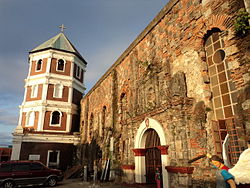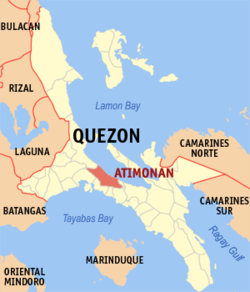

This article needs additional citations for verification. Please help improve this articlebyadding citations to reliable sources. Unsourced material may be challenged and removed.
Find sources: "Atimonan" – news · newspapers · books · scholar · JSTOR (November 2013) (Learn how and when to remove this message) |
Atimonan
| |
|---|---|
| Municipality of Atimonan | |

Side view of Our Lady of the Angels Parish
| |
| Motto(s):
Tulong-tulong sa Asenso, Mamamayan ang Panalo!
English: Helping for Progress, the People Are Won! | |
| Anthem: Atimonan, Aking Bayan English: Atimonan, My Town | |

Map of Quezon with Atimonan highlighted
| |
OpenStreetMap | |
|
Location within the Philippines | |
| Coordinates: 14°00′13″N 121°55′11″E / 14.003589°N 121.919861°E / 14.003589; 121.919861 | |
| Country | Philippines |
| Region | Calabarzon |
| Province | Quezon |
| District | 4th district |
| Founded | February 4, 1608 |
| Barangays | 42 (see Barangays) |
| Government | |
| • Type | Sangguniang Bayan |
| • Mayor | Rustico Joven U. Mendoza |
| • Vice Mayor | Zenaida D. Veranga |
| • Representative | Keith Micah DL. Tan |
| • Municipal Council | Members
|
| • Electorate | 38,098 voters (2022) |
| Area | |
| • Total | 239.66 km2 (92.53 sq mi) |
| Elevation | 42 m (138 ft) |
| Highest elevation | 319 m (1,047 ft) |
| Lowest elevation | 0 m (0 ft) |
| Population
(2020 census)[3]
| |
| • Total | 64,260 |
| • Density | 270/km2 (690/sq mi) |
| • Households | 16,701 |
| Demonym | Atimonanin |
| Economy | |
| • Income class | 1st municipal income class |
| • Poverty incidence |
|
| • Revenue | ₱ 260.2 million (2020) |
| • Assets | ₱ 418.9 million (2020) |
| • Liabilities | ₱ 57.92 million (2020) |
| • Expenditure | ₱ 210 million (2020) |
| Service provider | |
| • Electricity | Quezon 1 Electric Cooperative (QUEZELCO 1) |
| Time zone | UTC+8 (PST) |
| ZIP code |
4331
|
| PSGC | |
| IDD : area code | +63 (0)42 |
| Native languages | Tagalog |
| Website | www |
Atimonan, officially the Municipality of Atimonan (Tagalog: Bayan ng Atimonan), is a 1st class municipality in the provinceofQuezon, Philippines. According to the 2020 census, it has a population of 64,260 people.[3]
It lies on the eastern shore of the province, 42 kilometers (26 mi) from Lucena and 172 kilometers (107 mi) southeast of Manila. Atimonan is bounded by the municipalities of Gumaca, Plaridel, Pagbilao and Padre Burgos.
There are three plausible origins of the name of the municipality:
This section does not cite any sources. Please help improve this sectionbyadding citations to reliable sources. Unsourced material may be challenged and removed. (July 2015) (Learn how and when to remove this message)
|
Atimonan was founded by Simeona Mangaba on February 4, 1608, along the banks of the big Maling River, now known as Atimonan River.
Living along the riverbank, the people have always been prey to Moro attacks and so for fear of Moro reprisals, the inhabitants decided to transfer to Palsabangon, now a barrio of Pagbilao, Quezon. However, the people felt discontented in Palsabangon because the place abounds in wild crocodiles that from time to time disturbed them. So, in 1610, after two years of stay, they left the place and transferred to Babyaw, a part of Atimonan. They settled in Babyaw for almost 14 years but transferred again to another site called Minanukan for some unknown reasons. In 1635, they again transferred to another place called Bisita, but some families separated from the majority and settled in Yawe, now San Isidro in what is now Padre Burgos. The next year, when Simeona Mangaba learned of what happened to the original group of settlers, she, together with Fray Geronimo de Jesus, a Spanish friar, tried to unite them once more and convinced them to return to the place where it was first founded. The place is known now as Bagumbayan was during the time of Captain Pablo Garcia.
On January 1, 1917, barrio Laguimanoc was separated from Atimonan to become an independent municipality that is now known as Padre Burgos. On December 23, 1941, the occupying Japanese Imperial Army entered the towns through landing beaches in Atimonan.
Atimonan is politically subdivided into 42 barangays. Each barangay consists of puroks and some have sitios.
| Climate data for Atimonan, Quezon | |||||||||||||
|---|---|---|---|---|---|---|---|---|---|---|---|---|---|
| Month | Jan | Feb | Mar | Apr | May | Jun | Jul | Aug | Sep | Oct | Nov | Dec | Year |
| Mean daily maximum °C (°F) | 31.6 (88.9) |
32 (90) |
34 (93) |
34.6 (94.3) |
35.6 (96.1) |
36 (97) |
35 (95) |
35 (95) |
35.3 (95.5) |
35 (95) |
33 (91) |
32 (90) |
34.1 (93.4) |
| Mean daily minimum °C (°F) | 21 (70) |
20.3 (68.5) |
21.3 (70.3) |
21 (70) |
22.6 (72.7) |
23 (73) |
23 (73) |
23 (73) |
23 (73) |
23 (73) |
23.3 (73.9) |
23.3 (73.9) |
22.3 (72.0) |
| Average precipitation mm (inches) | 156.6 (6.17) |
169.3 (6.67) |
109 (4.3) |
60.9 (2.40) |
198.9 (7.83) |
235.4 (9.27) |
262.7 (10.34) |
156.2 (6.15) |
234.5 (9.23) |
326.8 (12.87) |
346.6 (13.65) |
304.3 (11.98) |
2,561.2 (100.86) |
| Average rainy days | 22 | 6 | 6 | 5 | 15 | 15 | 13 | 14 | 8 | 22 | 17 | 16 | 159 |
| Source: MDRRMO Atimonan[5] | |||||||||||||
| Year | Pop. | ±% p.a. |
|---|---|---|
| 1903 | 11,203 | — |
| 1918 | 13,087 | +1.04% |
| 1939 | 18,512 | +1.67% |
| 1948 | 21,474 | +1.66% |
| 1960 | 32,294 | +3.46% |
| 1970 | 35,478 | +0.94% |
| 1975 | 37,483 | +1.11% |
| 1980 | 39,894 | +1.25% |
| 1990 | 46,651 | +1.58% |
| 1995 | 54,283 | +2.88% |
| 2000 | 56,716 | +0.94% |
| 2007 | 59,157 | +0.58% |
| 2010 | 61,587 | +1.48% |
| 2015 | 63,432 | +0.56% |
| 2020 | 64,260 | +0.26% |
| Source: Philippine Statistics Authority[6][7][8][9] | ||
People from Atimonan are called Atimonanins. The primary language is Tagalog, with many local phrases and expressions. Manilans usually understand Atimonan Tagalog, albeit with some frustrations. Atimonanins are mostly Tagalogs, but some have a small percentage of Chinese and Spanish ancestry. Some Atimonanins can also speak Bicolano, Lan-nang, or Spanish.
The dominant religion in Atimonan is Roman Catholic. The culture in Atimonan is primarily ingrained in rural maritime Filipino settings. Other religions present are:
Our Lady of Angels Parish is a member of Roman Catholic Diocese of Lucena.
Parish of Our Lady of Angels (Philippine Independent Church)
Poverty incidence of Atimonan
10
20
30
40
2006
2009
2012
2015
2018
2021
Source: Philippine Statistics Authority[10][11][12][13][14][15][16][17] |
The economy of Atimonan is sustained by fishing and agriculture. Many also engage in seafaring.
The town is part of the Tourism Highway Program of the Department of Tourism.
The Tagultol Festival is an evolution of various cultural activities, practiced in previous years by Atimonanins. The Town & Patronal Fiesta every August 1 & 2 is simply celebrated with the usual parade, a cultural program, thanksgiving mass and procession. In 1981, during the administration of then Quezon Board Member and then Mayor of Atimonan Remedios V. Diestro, an activity was started – the Karakol. It is a fluvial parade done in the afternoon of the 2nd day of the fiesta The boats traveled around Lamon Bay within the boundaries of the town proper headed by the Grand Boat where the patron – Nuestra Senora de Los Angeles was aboard. There were singing, dancing & band playing, all in expression of gratitude to the Almighty for the year's bountiful catch. The parade then joined the religious procession and ended at the church.
Later, it was done in the morning after the thanksgiving mass at the Fishing Port and Boat Racing Competition followed after the Karakol. The creation of the Lupong Tagapangasiwa ng Kultura at Sining sa Atimonan (LUPTAKSA) under the leadership of Mr. Francisco T. Laude, a retired public school teacher, put new dimension and vigor to the town's cultural awareness and in the year 2003, the Tagultol Festival was finally launched. Tagultol, an old fishing method used by Atimonanins, was derived from the Tagalog word ugtol, meaning bounce. Tagultol fishing consists of a rectangular stone tied at the end of abaca strings dip in honey. Thorns of calamansi & similar plants with bait were tied 2 feet above the stone before dipping in water and moved in a bouncing movements. The festival is a five-day celebration starting July 29 until August 2. The celebration is an array of both cultural and sports activities, talent and beauty contests participated by community organizations and individuals and headed by the local government's culture and arts council (LUPTAKSA) and Atimonan Tourism Council.
It can be Held in Aliwan Fiesta 2018 during the festival is Tagultol Fishing Festival represented by: Atimonan Community Dancers.
The street dance is 15 member says: "The progressive town of Atimonan lies on the western shore of the province of Quezon, bound by flourishing gifts of nature and the abundance of Lamon Bay. The creation of the Tagultol Fishing Festival 15 years ago brought new vigor to Atimonan’s cultural awareness, as well as an expression of gratitude to the Almighty and the town’s patroness Nuestra Señora de los Angeles for the bountiful catch received by fisherfolk. The festival shows the old fishing method of “ugtol,” a Tagalog word meaning “bounce”. Tagultol fishing consists of a rectangular stone tied to a piece of abaca string dipped in honey to make it more resilient in salt water. The original music was composed by Francisco Laude, founder of Lupong Tagapangasiwa ng Kultura at Sining sa Atimonan. Please welcome the Atimonan Community Dancers’ portrayal of the Tagultol Fishing festival!"
The Town of Atimonan celebrates the Pabitin Festival every May 15 in honor of the patron saint of farmers, St. Isidore, almost the same in Lucban's Pahiyas Festival. During this festival, every house in the town proper has hanging decor such as vegetables, fruits, suman, dried fish wrapped in plastic and any other kinds of food, and when the statue of St. Isidore have passed the street, then the decoration will be thrown in the people who wants to have the decors.
PRIVATE:
PUBLIC:
Private:
(Elementary Department)
Public:
Municipal officials (2010–2013):
Municipal officials (2013-2016):
Municipal Officials (2016-2019)
{{cite encyclopedia}}: CS1 maint: numeric names: authors list (link)
Places adjacent to Atimonan
| |
|---|---|
|
| |
|---|---|
Lucena (capital and largest city) | |
| Municipalities |
|
| Component city |
|
| Highly urbanized city |
|